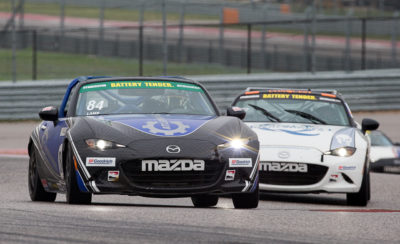During a race, things are going to change – the best drivers make the necessary adjustments to keep lap times on point.
Viewing from a strategic position during a Mazda Road to 24 Shootout, Scott Goodyear – one of previous judges, IndyCar race winner and 24 Hours of Le Mans podium finisher – observed something about one of the participants that impressed him.
“When he tried something and the car started to go out from underneath him, there was no panic in it,” Goodyear says. “And most importantly, when you do that as a driver and the car has been out from underneath you and something happened, a good driver will approach it still using the same braking point, then change something small in his approach to fix the problem. The drivers that don’t have the confidence to do that, their braking point will be way earlier and they’ll be much more relaxed at it. A confident driver goes back and attacks the turn, changes something a small amount, fixes it and moves on.”
It sounds relatively simple, but a pro like Jonathan Bomarito, driver of the Mazda RT-24P in the IMSA WeatherTech SportsCar Championship, says it’s one of the hardest things to do as a racing driver. “It’s how you balance the car into the corner. You have to be really in tune with what the car’s doing and what you’re doing from inside the cockpit with your hands and feet,” he says.
It can be a psychological game. Something in the car may have changed – tires may have gone off, you’ve burned some fuel, bashed a curb and adjusted your camber mid-race – so the driver needs to make an adjustment. But when you’re chasing or being chased, the wrong adjustment could mean critical lost time, so drivers are hesitant to move their marks. But you’ll also lose time if you keep doing whatever it is that isn’t working.
Explains Tom Long, Mazda factory driver and professional racing coach: “If all of a sudden you have more oversteer than you’ve had, say the rear tires have burned off … you need to think about which corners that is going to affect you the most. Prioritize that and then, from the process of elimination as you go around the track, think ‘OK, if I can later apex this corner, straighten my hands up sooner to get the car straighter, then I can go full throttle.’”
In full throttle lies the key, says Andrew Carbonell, who, like Long, is a coach and Mazda pro. Everything comes down to how soon you can have the butterflies wide open.
“You have to realize as the session goes on – as tires get hot, as the brakes get hot, that variables are changing – but we still always know that we want to be at full throttle at a certain point on a certain corner to maximize our lap time. So I always tell my guys to work it backwards,” Carbonell explains. “Find at what point in that corner you find full throttle and work it back from there. Manage your speed on entry to be able to commit to full throttle at that point. Maybe you can brake earlier or later and you will find in that tenth of a second right before you get to the apex, once you get to the throttle, you will know whether you got there too early or too late and then adjust accordingly.”
The car is never going to be the same throughout a race, even a 25-minute sprint, nor will it be the same as it was in qualifying. But if you can make the little adjustments necessary to work around those changes, you will lose much less in the way of lap time as the race goes on.


 ACCESSIBILITY
ACCESSIBILITY